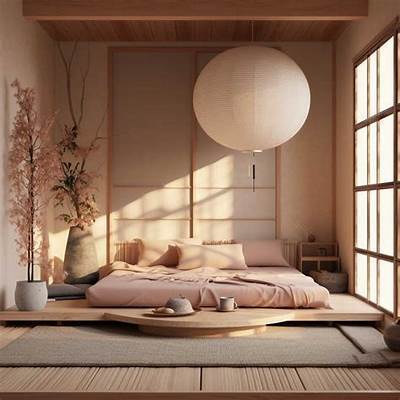Japanese Bedroom Design: A Guide to Serenity and Simplicity
The Japanese aesthetic, characterized by its minimalist approach and emphasis on natural elements, offers a pathway to creating a tranquil and calming bedroom sanctuary. Far from sterile or stark, Japanese bedroom design prioritizes functionality, harmony, and a deep connection with nature, resulting in spaces that are both beautiful and profoundly restful. This comprehensive guide explores the key principles and elements of Japanese bedroom design, offering inspiration and practical advice for transforming your space into a haven of peace.
Core Principles of Japanese Bedroom Design
Before diving into specific design elements, understanding the underlying philosophies of Japanese aesthetics is crucial. These principles serve as a guiding framework for creating a truly authentic Japanese-inspired bedroom:
1. Minimalism and Decluttering:
The cornerstone of Japanese design is *ma*, often translated as "space" or "emptiness." This isn't about barrenness, but rather a deliberate curation of possessions, keeping only what is essential and beautiful. A minimalist approach minimizes visual clutter, allowing the eye to rest and promoting a sense of calm. This requires a conscious decluttering process, discarding unnecessary items and storing others neatly out of sight.
2. Natural Materials and Textures:
Natural materials are integral to Japanese design, reflecting a deep respect for nature. Think natural wood, bamboo, paper, cotton, and linen. These materials introduce warmth, texture, and a subtle earthy aroma that contributes to a peaceful atmosphere. The use of natural fabrics for bedding and furnishings further enhances this connection to nature.
3. Natural Light and Airflow:
Maximizing natural light is crucial. Japanese homes often feature shoji screens or sliding doors made of translucent paper, allowing soft, diffused light to filter into the room. Good airflow is equally important, promoting a feeling of freshness and preventing stuffiness. Consider placing your bed strategically to allow for cross-ventilation.
4. Harmony and Balance:
The concept of *wabi-sabi*, embracing imperfection and impermanence, is another key aspect. This doesn't mean embracing chaos, but rather appreciating the beauty of natural imperfections and the transient nature of things. The overall design should strive for a sense of balance and harmony, with elements carefully arranged to create a visually pleasing and restful space.
5. Functionality and Simplicity:
Japanese design prioritizes functionality. Every item in the room should serve a purpose, and unnecessary ornamentation is avoided. Simple, clean lines and uncluttered surfaces are preferred, creating a sense of spaciousness and ease. Multifunctional furniture is a great way to maximize space and maintain simplicity.
Key Elements of a Japanese-Style Bedroom
Now let's explore the specific design elements that contribute to a successful Japanese bedroom:
1. The Bed:
The bed is the focal point of the room. A low platform bed, often made of wood, is a classic choice. It creates a sense of groundedness and harmony with the floor. Opt for a simple, natural mattress and bedding in muted colors, such as beige, grey, or white. Consider using a futon for a more traditional Japanese feel, which can be rolled up and stored during the day to maximize space.
2. Flooring:
Tatami mats are a traditional Japanese flooring choice, providing a soft, natural surface underfoot. However, if tatami mats aren't practical, consider light-colored hardwood floors or bamboo flooring, which echo the natural aesthetic. Rugs can be incorporated, but keep them simple and natural in texture and color.
3. Wall Decor:
Keep wall decor minimal. A single piece of calligraphy, a hanging scroll depicting nature, or a simple print can add visual interest without overwhelming the space. Avoid overly bright or busy artwork; instead, choose pieces that evoke a sense of tranquility and peace.
4. Lighting:
Soft, diffused lighting is essential. Avoid harsh overhead lighting; instead, use table lamps, floor lamps, or paper lanterns to create a warm and inviting atmosphere. Consider incorporating natural light by using sheer curtains or blinds to filter sunlight during the day.
5. Color Palette:
A neutral color palette is typically used in Japanese bedroom design. Think muted earth tones like beige, grey, taupe, and ivory. You can introduce subtle pops of color with accents like a throw pillow or a vase of flowers, but keep them restrained to maintain the overall sense of calm.
6. Storage:
Clever storage solutions are key to maintaining minimalism. Built-in closets, sliding doors, and under-bed storage are all excellent options. Keep storage units simple and unobtrusive, avoiding overly ornate or bulky pieces.
7. Plants:
Incorporating plants brings the outdoors in, adding a touch of life and freshness to the room. Choose small, low-maintenance plants like bonsai trees or bamboo, placing them strategically to enhance the overall aesthetic.
8. Accessories:
Accessories should be kept to a minimum. A few carefully chosen items, such as a ceramic vase, a simple wooden bowl, or a small sculpture, can add personality without cluttering the space. Avoid overly decorative or ornate accessories.
Creating a Japanese-Inspired Bedroom: A Step-by-Step Guide
Transforming your bedroom into a Japanese-inspired sanctuary involves a thoughtful and phased approach:
1. Declutter and Purge:
Begin by decluttering your bedroom completely. Get rid of anything you don't need or use, donating or discarding unnecessary items. This is the foundation for creating a minimalist space.
2. Choose Your Color Palette:
Select a neutral color palette that reflects the natural world. Consider using earth tones or shades of white and grey.
3. Select Natural Materials:
Choose natural materials for your bed, flooring, and other furnishings. Wood, bamboo, cotton, and linen are all excellent choices.
4. Incorporate Natural Light:
Maximize natural light by using sheer curtains or blinds. Strategically place lamps and other light sources to create a soft, diffused glow.
5. Implement Simple Storage Solutions:
Invest in simple, functional storage solutions to keep your belongings organized and out of sight.
6. Add Minimalist Decor:
Add a few carefully chosen pieces of artwork or accessories to personalize your space without overwhelming it.
7. Introduce Plants:
Incorporate a few small, low-maintenance plants to bring a touch of nature indoors.
8. Enjoy Your Tranquil Space:
Once you've completed these steps, step back and appreciate your newly created Japanese-inspired bedroom. Relax and enjoy the serenity and peace it provides.
By embracing the core principles of Japanese design and incorporating the elements discussed above, you can create a bedroom that is not only aesthetically pleasing but also a true haven of peace and tranquility. Remember, the goal is to create a space that promotes relaxation, reflection, and a deep connection with nature.


この記事へのコメント